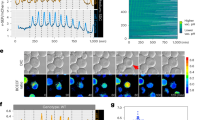Abstract
The p-fluorophenylalanine (FPA) resistance of acc phe, which has previously been shown (Brooks et al., 1972) to be a try-1 mutant, has been further investigated. When incubated in the absence of tyrosine, acc phe and also tyr-1 auxotrophs show a gradual increase in free phenylalanine in the cell but a sharp decrease in FPA incorporation into protein. The decrease in FPA incorporation is apparently due to the excess phenylalanine in the mutants, since the normal endogenous pool component in wild type and also in the mutants incubated on tyrosine does not appear to compete with FPA for incorporation. The rate of FPA incorporation into protein in acc phe remains at 10–15% of the wild-type rate even when the ratio of free FPA to excess phenylalanine in the cell is high as 8:1. If wild type is supplied with exogenous phenylalanine and FPA simultaneously, phenylalanine is preferentially incorporated into protein but, in contrast to the mutant, the rate of FPA incorporation increases as the ratio of free FPA to phenylalanine increases. On the basis of differences in competition with FPA and in susceptibilities to mild extraction procedures, it is proposed that phenylalanine can be located in at least three compartments in Neurospora: a small constant-size endogenous pool always seen in wild type; an expandable exogenous pool; and a protein synthesis pool which is preferentially populated by endogenous phenylalanine but can be entered by exogenous molecules when biosynthesis is regulated. In acc phe, where phenylalanine biosynthesis is not regulated, the excess phenylalanine is located primarily in the protein synthesis pool where it only has to compete with a small FPA component and is thereby preferentially incorporated into protein in this mutant.
Similar content being viewed by others
References
Adelberg, E. A. (1958). Selection of bacterial mutants which excrete antagonists of anti-metabolites. J. Bacteriol. 76326.
Brooks, C. J., DeBusk, B. G., DeBusk, A. G. and Catcheside D. E. A. (1972). A new class of p-fluorophenylalanine-resistant mutants in Neurospora crassa. Biochem. Genet. 6239.
Calvo, J. M., and Umbarger, H. E. (1969). Regulation of the branched-chain amino acid biosynthesis in Salmonella typhimurium: Isolation of regulatory mutants. J. Bacteriol. 971272.
Cowie, D. B., and Walton, B. P. (1964). Kinetics of Formation and Utilization of Metabolic Pools in the Biosynthesis of Protein and Nucleic Acids, Carnegie Institute of Washington Publ. 624, Washington, D. C.
DeBusk, B. G. (1968). Free amino acid pools in Neurospora crassa. Florida State University Alumni Studies Conference.
DeBusk, B. G., and DeBusk, A. G. (1967). The free amino acid pool of Neurospora. Neurospora Newsletter 111.
Gross, S. R. (1965). The regulation of the synthesis of leucine biosynthetic enzymes in Neurospora. Proc. Natl. Acad. Sci. 541538.
Kempner, E. S., and Cowie, D. B. (1960). Metabolic pools and the utilization of amino acid analogs for protein synthesis. Biochim. Biophys. Acta 42401.
Matchett, W. H., and DeMoss, J. A. (1964). Physiological channeling of tryptophan in Neurospora crassa. Biochim. Biophys. Acta 8691.
Vogel, H. J. (1956). A convenient growth medium for Neurospora (medium N). Microbial Genet. Bull. 1342.
Author information
Authors and Affiliations
Additional information
This work was supported, in part, by an Atomic Energy Commission grant to the Institute of Molecular Biophysics, The Florida State University, and by the Genetics Training Grant, funded by the National Institutes of Health. It contains, in part, data from the doctoral thesis of the senior author, who was supported by a Florida State University Nuclear Fellowship and by a Public Health Service Fellowship.
Rights and permissions
About this article
Cite this article
Brooks, C.J., DeBusk, A.G. Cellular compartmentation of aromatic amino acids in Neurospora crassa. I. Occupation of a protein synthesis pool by phenylalanine in Tyr-1 mutants. Biochem Genet 10, 91–103 (1973). https://doi.org/10.1007/BF00485751
Received:
Revised:
Issue Date:
DOI: https://doi.org/10.1007/BF00485751




